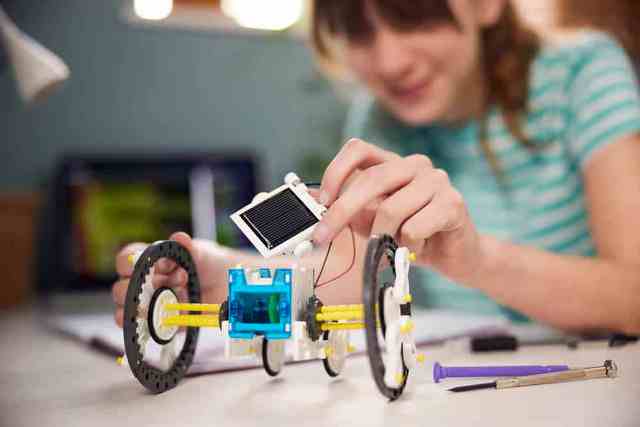For Parents
Fostering Passion: Igniting Teenagers' Interest in STEM
Admin Sep 19, 2023 11:49 AM

TAGS
In a rapidly advancing technological era, STEM (Science, Technology, Engineering, and Mathematics) fields play a pivotal role in shaping the future for the rapidly evolving technological landscape and offering a foundation for various career paths.High schoolers have the opportunity to delve deeper into STEM subjects, explore their interests, and develop skills that can lead to future academic and professional success.
However, engaging teenagers in STEM disciplines can sometimes be challenging due to misconceptions, perceived difficulty, or lack of exposure. Let’s explore some effective strategies for igniting teenagers' interest in STEM, highlighting the importance of early exposure, hands-on experiences, mentorship, and real-world relevance.
- Early Exposure and Exploration: Early exposure to STEM concepts is crucial for cultivating a genuine interest. Encourage exploration through interactive games, science kits, and age-appropriate experiments. Visits to science museums, planetariums, or science fairs can spark curiosity and lay the foundation for future STEM pursuits.
- Choosing Rigorous Core Curriculum: High school STEM education often starts with a strong foundation in core subjects such as mathematics, biology, chemistry, physics, and computer science. These subjects provide essential knowledge and critical thinking skills that form the basis for advanced studies. So you can help your teenage child to choose from these subjects.
- Hands-On Learning: Teenagers thrive when they can directly engage with STEM concepts. Provide opportunities for hands-on learning through projects, experiments, and practical applications. Building robots, coding games, or conducting chemistry experiments can make abstract theories come alive.
- Real-World Relevance: Showcasing the real-world applications of STEM fields can inspire teenagers. Highlight how STEM innovations contribute to solving global challenges, such as climate change, medical advancements, or space exploration. Demonstrating how STEM impacts their everyday lives can make the subjects more relatable and intriguing.
- Extracurricular Activities: Offer extracurricular activities like robotics clubs, coding workshops, or science competitions. These platforms provide a collaborative environment where teenagers can work on exciting projects, collaborate with peers, and showcase their creativity.
- Role Models and Mentorship: Introduce teenagers to successful individuals in STEM fields who can serve as role models. Arrange mentorship programs, where they can connect with professionals and gain insights into potential STEM careers. Seeing relatable role models can inspire them to pursue similar paths.
- Incorporate Creativity: Emphasize the creative aspects of STEM fields. Highlight how engineers design imaginative solutions, how mathematicians explore abstract patterns, and how scientists innovate through experimentation. Combining creativity with analytical thinking can appeal to teenagers' diverse interests.
- Interactive Learning Tools: Leverage technology to engage teenagers through interactive online courses, educational apps, and virtual simulations. These tools provide flexibility and allow them to explore STEM subjects at their own pace.
- Real-World Projects: Encourage teenagers to work on real-world projects that align with their interests. Whether it's designing a sustainable energy solution or creating a smartphone app, applying STEM knowledge to tangible projects fosters a sense of achievement and purpose.
- Connections to Pop Culture: Relate STEM concepts to popular culture phenomena, such as the science behind movie special effects or the technology driving video games. Linking STEM to their interests can captivate teenagers and make the subjects more appealing.
- Parental Support and Engagement: Parents play a crucial role in nurturing STEM interest. Encourage open conversations about STEM, support their exploration, and explore STEM activities together as a family. Family engagement can create a positive environment for learning.
- Career Pathways and Electives: Some high schools offer specialized STEM pathways or electives that allow students to focus on specific fields such as engineering, computer science, or biomedical sciences. These pathways provide a structured approach to in-depth study.
- STEM Competitions: High schoolers can participate in STEM competitions at local, regional, and even national levels. Competitions like science fairs, math Olympiads, and robotics competitions allow students to showcase their skills and innovation.
- Dual Enrollment and College Courses: Some high schools allow students to take college courses or enroll in dual enrollment programs, giving them the opportunity to earn college credits and experience higher-level STEM education.
- Internships and Research Opportunities: High school students interested in STEM can seek out internships or research opportunities with universities, research institutions, or local businesses. These experiences provide hands-on exposure to the professional STEM world.
- Online Resources and Coding: High schoolers can explore online resources and coding platforms to learn programming languages, develop apps, or build websites. In today’s tech driven world, these skills are highly valuable.
Conclusion: Incorporating STEM education into high school not only equips students with essential knowledge and skills but also fosters curiosity, innovation, and a deeper understanding of the world around them. Whether students pursue further studies in STEM fields or apply STEM principles in other domains, a solid high school STEM education lays the groundwork for a successful and impactful future.
Search
Latest Blogs

Exploring Opportunities in Emerging Engineering field
Admin
Dec 14, 2024 05:18 PM

Navigating College Majors
Admin
Sep 25, 2024 04:04 PM

Tools for Measuring Strengths For Career
Admin
Sep 25, 2024 03:27 PM
Interested in getting latest updates?
SUBSCRIBE


















